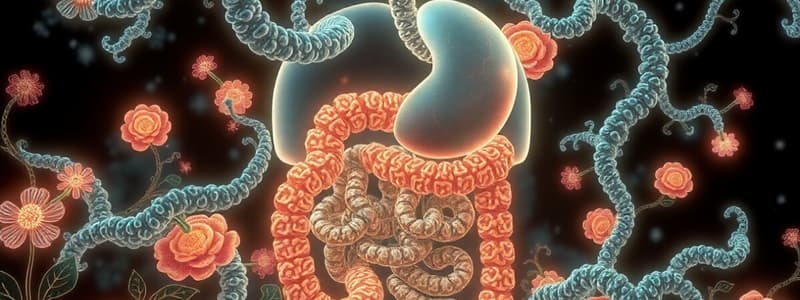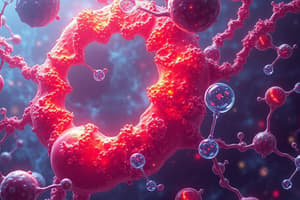Podcast
Questions and Answers
Which type of macromolecule is primarily responsible for providing quick energy to cells?
Which type of macromolecule is primarily responsible for providing quick energy to cells?
- Lipids
- Carbohydrates (correct)
- Nucleic acids
- Proteins
What is the function of enzymes in the digestive process?
What is the function of enzymes in the digestive process?
- Increase the amount of water in the body
- Store energy reserves for later use
- Act as catalysts to speed up chemical reactions (correct)
- Direct the organism’s growth
Which process is described as breaking down macromolecules with the help of water?
Which process is described as breaking down macromolecules with the help of water?
- Absorption
- Hydrolysis (correct)
- Metabolism
- Dehydration synthesis
What is the primary role of lipids in the body?
What is the primary role of lipids in the body?
Which type of feeder lives on or in a food source and continuously consumes it?
Which type of feeder lives on or in a food source and continuously consumes it?
Which of the following is NOT a major category of macromolecules?
Which of the following is NOT a major category of macromolecules?
What component of water is vital for maintaining fluid balance in the body?
What component of water is vital for maintaining fluid balance in the body?
Which macromolecule contains the genetic information of an organism?
Which macromolecule contains the genetic information of an organism?
What is the primary function of the folded muscle walls of the stomach?
What is the primary function of the folded muscle walls of the stomach?
Which enzyme is primarily responsible for breaking down proteins in the stomach?
Which enzyme is primarily responsible for breaking down proteins in the stomach?
What substance is formed in the stomach after food is mixed with gastric juices?
What substance is formed in the stomach after food is mixed with gastric juices?
What is the role of the pyloric sphincter in the digestive system?
What is the role of the pyloric sphincter in the digestive system?
In which part of the small intestine does the majority of nutrient absorption occur?
In which part of the small intestine does the majority of nutrient absorption occur?
What is the primary function of bile salts in digestion?
What is the primary function of bile salts in digestion?
Which structure in the small intestine is responsible for further increasing surface area for absorption?
Which structure in the small intestine is responsible for further increasing surface area for absorption?
What is the role of the pancreas in the digestive process?
What is the role of the pancreas in the digestive process?
What is the primary function of the esophagus in the digestive system?
What is the primary function of the esophagus in the digestive system?
Which process describes the breakdown of food into smaller molecules by enzymes?
Which process describes the breakdown of food into smaller molecules by enzymes?
What role does saliva play in digestion?
What role does saliva play in digestion?
What process occurs in the stomach to aid in digestion?
What process occurs in the stomach to aid in digestion?
What is the function of the tongue in the digestive process?
What is the function of the tongue in the digestive process?
Which statement is true about mechanical digestion?
Which statement is true about mechanical digestion?
What structure prevents food from entering the trachea during swallowing?
What structure prevents food from entering the trachea during swallowing?
Why do herbivores typically have longer digestive tracts?
Why do herbivores typically have longer digestive tracts?
Flashcards
Macromolecules
Macromolecules
Large molecules made up of smaller molecules linked together.
Essential Nutrients
Essential Nutrients
Essential nutrients that provide energy, regulate cell activities, and build/repair tissues.
Metabolism
Metabolism
The sum of all chemical reactions occurring in an organism.
Monosaccharide
Monosaccharide
Signup and view all the flashcards
Polysaccharide
Polysaccharide
Signup and view all the flashcards
Hydrolysis
Hydrolysis
Signup and view all the flashcards
Enzymes
Enzymes
Signup and view all the flashcards
Ingestion
Ingestion
Signup and view all the flashcards
Absorption
Absorption
Signup and view all the flashcards
Elimination
Elimination
Signup and view all the flashcards
Alimentary Canal
Alimentary Canal
Signup and view all the flashcards
Mechanical Digestion
Mechanical Digestion
Signup and view all the flashcards
Chemical Digestion
Chemical Digestion
Signup and view all the flashcards
Peristalsis
Peristalsis
Signup and view all the flashcards
Stomach
Stomach
Signup and view all the flashcards
Rugae
Rugae
Signup and view all the flashcards
Pepsin
Pepsin
Signup and view all the flashcards
Chyme
Chyme
Signup and view all the flashcards
Pyloric Sphincter
Pyloric Sphincter
Signup and view all the flashcards
Villi
Villi
Signup and view all the flashcards
Microvilli
Microvilli
Signup and view all the flashcards
Pancreas
Pancreas
Signup and view all the flashcards
Liver
Liver
Signup and view all the flashcards
Study Notes
Digestive System Quiz
- Macromolecules: Large molecules formed from smaller ones, essential nutrients for energy, cellular regulation, and tissue repair. These include carbohydrates, lipids, proteins, and nucleic acids. Metabolism is the sum of all chemical reactions in an organism.
Four Major Categories of Macromolecules
- Carbohydrates: Provide quick energy for cells. These include monosaccharides (single sugars), disaccharides (two sugars), and polysaccharides (many sugars). Examples include glucose and starch.
- Lipids: Store energy, cushion organs, and build cell membranes. Examples include fats and oils.
- Proteins: Build tissues, muscles, blood cells and aid in immune response and transports ions. Examples include enzymes (catalysts that speed up reactions) and hormones.
- Nucleic Acids: Contain genetic information. Examples include DNA (genetic information) and RNA (directing organism's growth and function).
Hydrolysis
- Chemical reaction that breaks apart macromolecules using water. Macromolecules must be broken down to smaller, absorbable molecules for cells.
Enzymes
- Enzymes help break down macromolecules by acting as catalysts. Enzymes aren't used up in the reaction and increase reaction rate. Enzyme names generally end in "ase".
Importance of Water in the Body
- Water transports nutrients, removes waste, lubricates tissues, regulates body temperature, and is a major component of bodily fluids.
Animals Obtaining Food
- Filter Feeders: Filter small organisms from water (e.g. tube worms).
- Substrate Feeders: Live on or in a food source and eat it (e.g., earthworms, caterpillars).
- Fluid Feeders: Consume nutrient-rich fluids (e.g., butterflies).
- Bulk Feeders: Consume large chunks of food (e.g., humans).
Four Stages of Food Processing
- Ingestion: Taking in food.
- Digestion: Breaking down food mechanically and chemically into smaller molecules.
- Absorption: Transporting digested nutrients from the digestive system to the circulatory system to be used throughout the body.
- Elimination: Removal of undigested waste.
The Alimentary Canal
- Long tube where food passes and is processed, starting at the mouth and ending at the anus. Different organs process food in different ways. Mechanical digestion includes physical breakdown from larger chunks to smaller pieces via teeth and muscle contractions.
Chemical Digestion
- Breaks down macromolecules into functional units using enzymes.
Human Digestive System
-
Mouth: Mechanical and chemical digestion occurs here. Saliva contains amylase to break down carbohydrates, and lubricates the food for swallowing.
-
Esophagus: Muscular tube connecting the mouth to the stomach, moving food via peristalsis. The esophageal sphincter is a muscular valve at the bottom of the esophagus to prevent backflow to the mouth.
-
Stomach: Mechanical and chemical digestion which holds food and churns it with gastric juices. Gastric juices include hydrochloric acid and enzymes like pepsin to break down proteins.
-
Small Intestine: Chemical digestion continues and absorption occurs. The small intestine is lined with villi and microvilli to increase surface area for absorption. Accessory organs such as the pancreas, liver, and gallbladder contribute enzymes and bile to aid digestion .
-
Large Intestine (Colon): Water is reabsorbed, bacteria continue food breakdown and produce vitamins, and waste forms feces.
-
Rectum: Stores feces before elimination through the anus.
Accessory Organs
- Pancreas: Produces digestive enzymes and the hormone insulin.
- Liver: Produces bile to aid fat digestion.
- Gallbladder: Stores bile until needed.
Factors Affecting Enzyme Activity
- Temperature and pH affect enzyme function (each enzyme has optimal conditions). Enzymes denature when conditions are not optimal.
Studying That Suits You
Use AI to generate personalized quizzes and flashcards to suit your learning preferences.
Related Documents
Description
Test your knowledge about the digestive system and its macromolecules with this quiz. Explore the four major categories: carbohydrates, lipids, proteins, and nucleic acids, along with their functions and examples. Assess your understanding of metabolism and hydrolysis processes involved in digestion.




